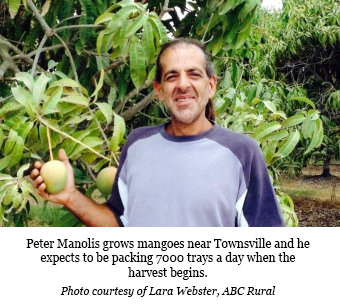by Lara Webster, ABC
 As the Queensland mango picking season looms, the industry is forecasting a drop in national production.
As the Queensland mango picking season looms, the industry is forecasting a drop in national production.
Pre-harvest preparations have begun in the Sunshine State, and the Australian Mango Industry Association has anticipated the national crop will be down by about one-and-a-half million trays from last year’s record crop of 9.5 million.
Chief executive officer Robert Gray said the main contributing factor to the reduction was late flowering.
“We’ve had a split flowering across all of the production regions this year, and that’s largely come as a result of the winter,” he said.
“From the Northern Territory all the way down all the production regions in Queensland, you’ve got the same thing happening where, on most farms, you’ve got two, three or sometimes even four separate fruit sets.”
Although there might be fewer mangoes and consumers will need to wait longer to buy them, Mr Gray said everyone could look forward to good quality fruit.
“Bricks levels, which are a good indicator of flavour, are high so far this season [and] all the work that we’ve been doing at a grower level is indicating really good responses to that focus on when to pick.”
North Queensland harvest
Four million trays have been estimated to be packed in Queensland, which is about the same as in the Northern Territory.
In North Queensland harvesting will get underway in November.
At Kelso, south of Townsville, Peter Manolis has begun preparations to harvest 30,000 trees.
His picking will get underway in mid-November, which is about six weeks later than usual for the Burdekin.
Despite the late start, Mr Manolis expected to see good production and estimated 7,000 trays a day would be packed for about four weeks.
To achieve that kind of production, he will employ a workforce of 100 pickers and packers.
“Our day of operation would last up to 12 or 14 hours a day and we pack seven days a week,” Mr Manolis said.
Most of the fruit will be sent overseas to Asia, Europe and Russia, with only some sent to the domestic markets in Brisbane and Sydney.
“To stay viable as a farm you must at least market some of your fruit overseas,” Mr Manolis said.
Source: ABC Rural
